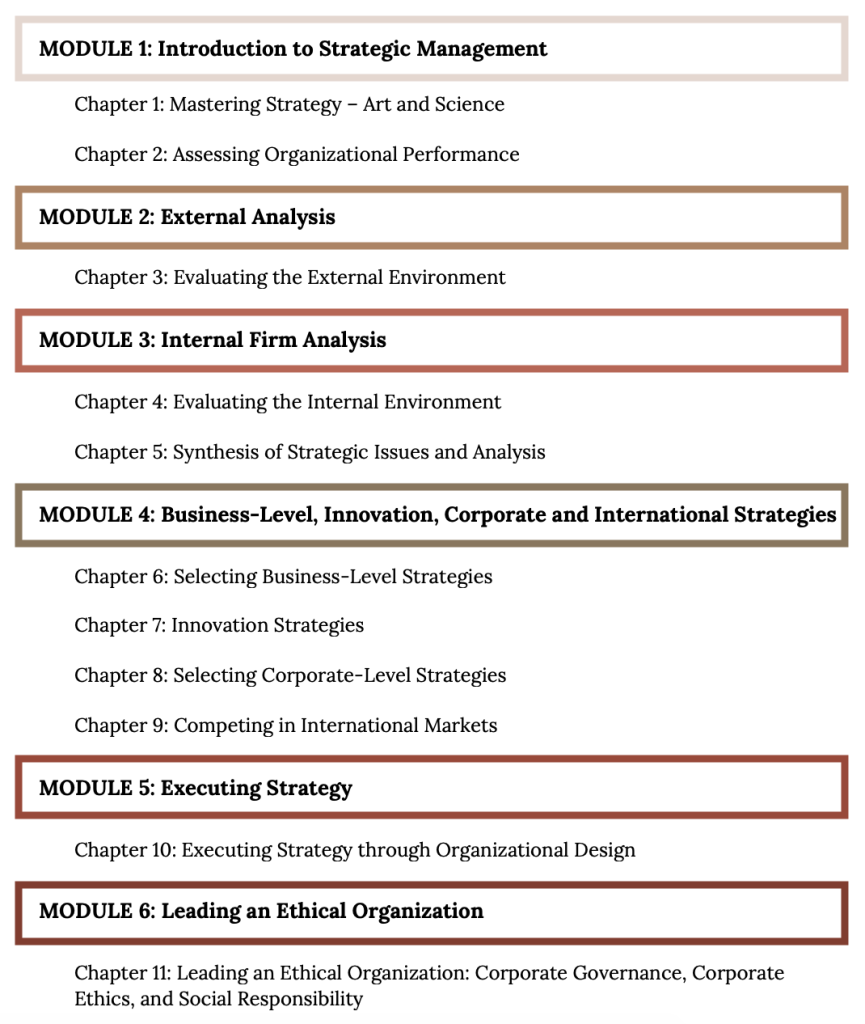Chapter 1: Mastering Strategy: Art and Science
1.6 Understanding the Strategic Management Process
Strategic management is a process that involves building a careful understanding of how the world is changing, as well as a knowledge of how those changes might affect a particular firm. CEOs, such as late Apple founder Steve Jobs, must be able to carefully manage the possible actions that their firms might take to deal with changes that occur in their environment. We present a model of the strategic management process in Figure 1.7, “Overall Model of the Strategic Management Process”. This model also guides our presentation of the chapters contained in this book.

The strategic management process begins with an understanding of strategy and performance. As we have noted in this introductory chapter, strategic management is both an art and a science, and it involves multiple conceptualizations of the notion of strategy drawn from recent and ancient history. In Chapter 2 “Assessing Organizational Performance”, we focus on how the organization’s mission and vision shape the development of the firm’s strategy. Consequently, how managers understand and interpret the performance of their firms is often central to understanding strategy.
Environmental and internal scanning is the next stage in the process. Managers must constantly scan the external environment for trends and events that affect the overall economy, and they must monitor changes in the particular industry in which the firm operates. For example, Apple’s decision to create the iPhone demonstrates its ability to interpret that traditional industry boundaries that distinguished the cellular phone industry and the computer industry were beginning to blur. At the same time, firms must evaluate their own resources to understand how they might react to changes in the environment. For example, intellectual property is a vital resource for Apple. Between 2008 and 2010, Apple filed more than 350 cases with the US Patent and Trademark Office to protect its use of such terms as apple, pod, and safari (Apple Inc.).
A classic management tool that incorporates the idea of scanning elements both external and internal to the firm is SWOT (strengths, weaknesses, opportunities, and threats) analysis. Strengths and weaknesses are assessed by examining the firm’s internal resources, while opportunities and threats refer to external events and trends. The value of SWOT analysis parallels ideas from classic military strategists such as Sun Tzu, who noted the value of knowing yourself as well as your opponent. Chapter 3 “Evaluating the External Environment” examines the topic of evaluating the external environment in detail, and Chapter 4 “Evaluating the Internal Environment” presents concepts and tools for managing firm resources. Synthesizing the information gained in the external and internal analysis into a SWOT framework is addressed in Chapter 5. The SWOT is then used to formulate the strategic issue(s) that the firm must deal with as it formulates strategies.

Strategy formulation is the next step in the strategic management process. This involves developing specific strategies and actions. Certainly, part of Apple’s success is due to the unique products it offers the market, as well as how these products complement one another. A customer can buy an iPod that plays music from iTunes—all of which can be stored in Apple’s Mac computer (Inside CRM Editors, n.d.). In Chapter 6 “Selecting Business-Level Strategies”, we discuss how selecting business-level strategies helps to provide firms with a recipe that can be followed that will increase the likelihood that their strategies will be successful. In Chapter 7, “Innovation Strategies”, we present insights on the role innovation plays in strategy development and implementation. Chapter 8 “Selecting Corporate-Level Strategies” focuses on selecting corporate-level strategies, and Chapter 9 “Competing in International Markets” presents possibilities for firms competing in international markets. Strategy implementation is the final stage of the process. One important element of strategy implementation entails crafting an effective organizational structure and corporate culture. For example, part of Apple’s success is due to its consistent focus on innovation and creativity that Steve Jobs described as similar to that of a start-up. Chapter 10 “Executing Strategy through Organizational Design” offers ideas on how to manage these elements of implementation. The final chapter explores how to lead an ethical organization through corporate governance, social responsibility, and sustainability.
Section Video
Strategic Management Process [04:35]
The video for this lesson explains the strategic management process.
You can also view this video at the following URL: https://youtu.be/o0U0gwvnhek.
Key Takeaway
- Strategic management is a process that requires the ability to manage change. Consequently, executives must be careful to monitor and to interpret the events in their environment, to take appropriate actions when change is needed, and to monitor their performance to ensure that their firms are able to survive and, it is hoped, thrive over time.
Exercises
- Who makes the strategic decisions for most organizations?
- Why is it important to view strategic management as a process?
- What are the four steps of the strategic management process?
- How is chess relevant to the study of strategic management? What other games might help teach strategic thinking?
References
Apple Inc. Litigation. In Wikipedia. en.wikipedia.org/wiki/Apple_Inc._ litigation.
Inside CRM Editors. (n.d.). Effective strategies Apple uses to create loyal customers. Retrieved from https://it.toolbox.com/blogs/inside-crm/11-effective-strategies-apple-uses-to-create-loyal-customers-100109.
Image Credits
Figure 1.7: Kindred Grey (2020). “Chapter Layout for Strategic Management.” CC BY-SA 4.0. Retrieved from https://commons.wikimedia.org/wiki/File:Chapter_Layout_for_Strategic_Management.png.
Figure 1.8: Shirinsokhan, Mahmoudreza. “Chess” CC BY-NC 2.0. Retrieved from https://flic.kr/p/bPNmxi.
Video Credits
Afra Alnaimi. (2014, November 29). Strategic Management Process [Video]. YouTube. https://youtu.be/o0U0gwvnhek.

